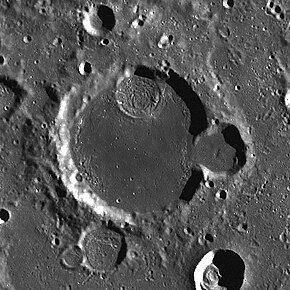Baldet (lunar crater)
 LRO image | |
| Coordinates | 53°18′S 151°06′W / 53.3°S 151.1°W |
|---|---|
| Diameter | 55 km |
| Depth | Unknown |
| Colongitude | 153° at sunrise |
| Eponym | Fernand Baldet |

Baldet is a lunar impact crater that is located on the southern hemisphere on the far side of the Moon. It lies in the lava-flooded region between the craters Cori to the north, Stoney to the southwest, and the worn walled plain Minkowski to the southeast.
The rim of Baldet is low and worn, but generally retains its original circular shape. There is a slight outward bulge along the northwest rim, and the western interior wall is wider than elsewhere.
The flat, nearly featureless interior has been flooded by lava, and has a lower albedo than the surroundings giving is a darker hue. A smaller crater has broken into the eastern rim, leaving a gap where the two craters intersect that has been covered in lava. A similar-sized ghost crater lies just inside the northern rim, producing a raised ring in the crater surface. Another such formation lies just outside the southern rim of Baldet.
Satellite craters
By convention these features are identified on lunar maps by placing the letter on the side of the crater midpoint that is closest to Baldet.
| Baldet | Latitude | Longitude | Diameter |
|---|---|---|---|
| J | 54.6° S | 149.5° W | 17 km |
References
- Andersson, L. E.; Whitaker, E. A. (1982). NASA Catalogue of Lunar Nomenclature. NASA RP-1097.
{{cite book}}: Invalid|ref=harv(help) - Blue, Jennifer (July 25, 2007). "Gazetteer of Planetary Nomenclature". USGS. Retrieved 2007-08-05.
{{cite web}}: Invalid|ref=harv(help) - Bussey, B.; Spudis, P. (2004). The Clementine Atlas of the Moon. New York: Cambridge University Press. ISBN 978-0-521-81528-4.
{{cite book}}: Invalid|ref=harv(help) - Cocks, Elijah E.; Cocks, Josiah C. (1995). Who's Who on the Moon: A Biographical Dictionary of Lunar Nomenclature. Tudor Publishers. ISBN 978-0-936389-27-1.
{{cite book}}: Invalid|ref=harv(help) - McDowell, Jonathan (July 15, 2007). "Lunar Nomenclature". Jonathan's Space Report. Retrieved 2007-10-24.
{{cite web}}: Invalid|ref=harv(help) - Menzel, D. H.; Minnaert, M.; Levin, B.; Dollfus, A.; Bell, B. (1971). "Report on Lunar Nomenclature by the Working Group of Commission 17 of the IAU". Space Science Reviews. 12 (2): 136–186. Bibcode:1971SSRv...12..136M. doi:10.1007/BF00171763.
- Moore, Patrick (2001). On the Moon. Sterling Publishing Co. ISBN 978-0-304-35469-6.
{{cite book}}: Invalid|ref=harv(help) - Price, Fred W. (1988). The Moon Observer's Handbook. Cambridge University Press. ISBN 978-0-521-33500-3.
{{cite book}}: Invalid|ref=harv(help) - Rükl, Antonín (1990). Atlas of the Moon. Kalmbach Books. ISBN 978-0-913135-17-4.
{{cite book}}: Invalid|ref=harv(help) - Webb, Rev. T. W. (1962). Celestial Objects for Common Telescopes (6th revised ed.). Dover. ISBN 978-0-486-20917-3.
{{cite book}}: Invalid|ref=harv(help) - Whitaker, Ewen A. (1999). Mapping and Naming the Moon. Cambridge University Press. ISBN 978-0-521-62248-6.
{{cite book}}: Invalid|ref=harv(help) - Wlasuk, Peter T. (2000). Observing the Moon. Springer. ISBN 978-1-85233-193-1.
{{cite book}}: Invalid|ref=harv(help)

